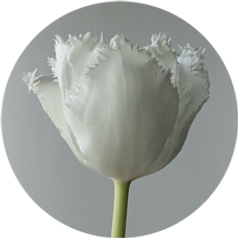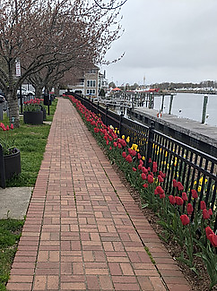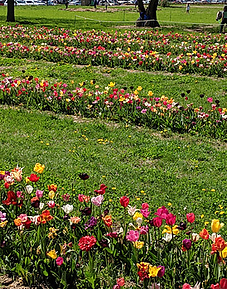It’s so exciting to see the first flowers peeking out of the cold winter soil. You know that winter is almost behind you when the first snowdrops appear. But when you see the leaves of tulips push through the warmer soil, you know spring is in the air. Soon you’ll be enjoying the many colors and styles of these cup shaped flowers. Be it double or single, fringed or twisted, no one can deny the beauty of the tulip. In this post you will learn everything about tulips that you need to know to add beauty to your garden, including some history.
(Some of the links within this post are affiliate links on which I receive a small compensation from the sale of certain items.)
(As a Amazon Associate I earn from qualifying purchases.)
Let’s Travel Back In Time
When you think of tulips you probably think of the Netherlands and Holland. Holland consists of two provinces within the 12 provinces of the Netherlands. So Holland is found within the Netherlands. I’m glad that’s cleared up!!
However, tulips were once a wild flower growing in Central Asia, far from the Netherlands…..an entire continent away! They were first cultivated by the Turks back around 1000AD and then in the 16th century became all the craze in the Ottoman Empire. The Sultan at that time craved the beauty of the tulip and demanded they be grown and cultivated for him. The name tulip was derived from the Turkish word for turban.

Time to Skip Ahead-How Tulips Came to the Netherlands
Jumping ahead to the early 18th century, tulips remained popular in Turkey where festivals took place to celebrate the “Age of Tulips” or the “Tulip Era”. But before that around 1590, a botanist named Carolus Clusius, originally from Venice, was asked to be director of the oldest botanical garden in Europe.
It was called Hortus Botanicus and located in Leiden, The Netherlands. There he was commissioned to explore different flora and their medicinal values. His friend, a Turk, who was the ambassador to Constantinople (now Istanbul), saw the lovely tulips and decided to send some to Carolus to add to his garden in Leiden.

In the 17th century tulips were planted in the fields of Holland for their beauty rather than their medicinal purposes. Botanists started to hybridize the tulips and created glorious varieties. Some of these varieties were valued more than a house back in the early 1600’s! This era lead to what was called “Tulipmania”. Since the high prices for tulips were not sustainable, there was eventually an economic crash in The Netherlands.
The late 17th and the 18th centuries proved to be more prosperous, the economy recovered, and the fascination with tulips continued to the present day.

Medicinal Values of Tulips
- Believe it or not tulips have many medicinal values.
- remedy for cough and cold
- reduces risk of cancer
- reduces sinus pain, hay fever and headache
- poultice (medicinal ointment) for insect bites, bee stings, rashes and burns
How to make poultice (Source: YoGem.com/answers)
- warm 2 to 4 flowers in hot water
- dip a towel in the water and add the petals into the towel
- roll the towel to crush the petals
- apply crushed petals onto sore area and hold there for 10 minutes
Planting Tulips – The Perennial Bulb
When and How to Plant Tulips
The best time to plant tulip bulbs is in the fall. If you received tulips as a gift for Easter or any other occasion, refer to my previous post regarding Easter bulbs. This will explain what to do with the flowers before the fall.
(As a Amazon Associate I earn from qualifying purchases.)
Plant the bulbs (from Amazon) when the soil temperature is 60 degrees Fahrenheit or colder, usually in September or October in the Northern Hemisphere and March or April in the Southern Hemisphere. The spot you choose should be in a full sun or partial sun area with well drained soil. Plant the bulbs 8 inches deep with the tips of the bulb facing up and 4 to 5 inches apart. I like to add a little bone meal as fertilizer in the hole before adding the bulb. Cover them with soil and water them well. You will not have to water them again. Now just wait for spring.
Dividing bulbs

If your tulips have become over crowded and seem to be on top of one another, it is probably time to divide them. However, it is extremely important to not divide them until all the nutrients from the leaves and flower have gone back to the bulb. This usually happens around midsummer to mid-fall. You will know when it is time when the flower and leaves turn yellow, then brown.
The bulbs are probably around 8 inches deep, therefore, you should begin by digging down around the perimeter of the tulips with a spade shovel. Then gently dig horizontally underneath the bulbs. Replant them in a sunny well-drained area with plenty of good soil 8 inches deep. You may want to put a little peat moss in the hole to allow for better drainage along with some bone meal or special bulb fertilizer (from Amazon). Fill in the hole and hopefully they will provide you with glorious blooms the next season.
(As a Amazon Associate I earn from qualifying purchases.)
So Many Varieties!
There are 3,000 registered types of tulips – Amazing! Botanists make it easy for us by grouping them into 14 varieties.
1. Single early – These are the earliest to bloom and have a cup shape with six petals.
2. Single late – This tulip is the tallest variety with a regular cup shape and has a wide range of colors and edges.
3. Darwin hybrid – A cross between Fosteriana tulip and late-blooming single tulips and used for cut flowers. The color ranges from reddish-orange to red.
4. Double early and Double late – These beauties resemble peonies because they have multi-layered blooms.
5. Fringed – I’m sure you’ve seen these before with their lovely fringe and frilly appearance. They are also known as “Crispa” tulips.
6. Fosteriana – Descendents of the wild tulips from Asia, with a bowl shape and large leaves.
7. Greigii – These are the giants of tulips. Their bowl shaped flower can reach 6 inches across and opens wide to the sunshine.

8. Kaufmanniana – Due to the pointed petals they resemble waterlilies. The blooms can measure 8 inches across. They are native to Turkestan.
9. Lily-flowered – These unique blooms have long pointed petals which resemble the old species in Turkey. They are very tall with stems averaging 24 inches, with some topping out at 32 inches!
10. Parrot – These tropical parrot looking flowers come in a variety of colors.They have feathery petals and are very delicate.
11. Viridiflora – Sometimes called the green tulip, green runs through its cup shaped flower. They have an extremely long bloom time.
12. Species – “Jewel of the Garden” tulips are descendants of the first tulip. They were discovered in the Mediterranean, Asia Minor and the Caucasus.
13. Triumph – Triumph tulips will live in vases much longer than other varieties. As a bonus some are even sweet smelling.
14. Rembrandt – The Dutch painter Rembrandt lived in Holland at the time of the tulip craze. A variety was named after him even though there are no known images of tulips in his paintings.
Tantalizing Tulip Tidbits!
1.Tulips attract bees which make for great pollination. In addition to bees, they also attract aphids, slugs, mites, larvae and caterpillars. Click here for more information on bees.
2. Unfortunately voles and squirrels like tulip bulbs. Rabbits, deer, chipmunks, mice and moles also enjoy nibbling on the bulbs. Use protective barriers or natural repellents to try and contain this problem. If you’d like to learn more about this topic, refer to my post Those Darn Rabbits.
3. Different colors of tulips have different meanings. For instance, white tulips represent worthiness and are used to convey a message of forgiveness. Purple tulips represent royalty and red tulips are all about love.
4. To preserve your cut tulips in a lovely vase, fill the vase a third full with a solution of one teaspoon of sugar and two drops of liquid bleach to a gallon of water. Refresh the water every couple of days and keep them in a cool room.

5. Tulips are toxic to cats, dogs and horses. They can be fatal if eaten.
6. Common varieties of tulips can be purchased at your local garden supply store. However, if you’d prefer a more exotic variety, you can purchase them through catalogues like Brecks.
If you prefer to buy ready blooming tulips or would like a beautiful bouquet, click Flowers Fast.

Tiptoe Through The Tulips
There are many places to feast your eyes on these lovely flowers. One place I highly recommend is the little town of Lewes in Delaware. Lewes was founded in 1631, on the site of one of the first European settlements in America. Dutch settlers founded the town as a post for whaling and trading. The town was named Zwaanendael (Swan Valley) but ,unfortunately, the 32 settlers were wiped out by the Lenape Native Americans in 1632.
Tulip Festivals
The Dutch returned at various times during the 17th century and brought many tulips to the area. Today Lewes has a tulip festival every year in mid-April to celebrate its heritage and the beauty of the tulips.
Holland, Michigan’s tulip festival is held in the beginning of May. This area contains about 4.5 million tulips and this is probably the largest tulip festival in the United States. Skagit Valley Tulip Festival in Mount Vernon, Washington is another place to view gorgeous tulips. Listed below are other tulip festivals.
- Tulip Time Festival, Pella, Iowa
- Holland Ridge Farms U-Pick Tulips, Cream Ridge, New Jersey
- Tulip Festival at Thanksgiving Point, Lehi, Utah
- Albany Tulip Festival, Albany, New York
- Tulipmania, San Francisco, California

Everything About Tulips/Final Thoughts
As you can see there is a lot to know about tulips. I hope this post provided valuable information and met your expectations regarding everything about tulips. If you have any questions or comments, please leave them below. I’d love to hear from you!
Happy Gardening!
Nina
bestgardeningforbeginners@gmail.com


